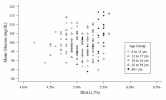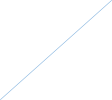Eddy Edson
Well-Known Member
- Relationship to Diabetes
- Type 2

Continuous Glucose Monitoring Profiles in Healthy Nondiabetic Participants: A Multicenter Prospective Study
This study provides normative sensor glucose data in a healthy, nondiabetic population of children and adults.
A fairly large study from 2019 seeking to map out what "normal" BG profiles look like during the day and overnight, using CGM measures; often see it cited. Perhaps useful resource for people looking to benchmark themselves against "normal" etc.
Units are mainly in American for BG (mg/dl: divide by 18 for mmol/l) and for HbA1c (%; easy to find tools on-line for conversion to mmol/mol).
There is some circularity: the main thing for deciding whether somebody is "non-diabetic" is their HbA1c, so no surprise if BG profiles are very broadly consistent with a non-diabetic HbA1c.
Also: this is an American study so the HbA1c cut-off is tighter: 5.7% = 39 mmol/mol instead of 42. So you would expect the BG profiles here to be maybe also a bit "tighter" than if the UK cut-off had been used.
Main table: https://academic.oup.com/view-large/204688211
Some points:
- Median daily BG increases a bit with age: 5.5 mmol/l for 25 - 60 yrs; 5.8 mmol/l for 60+.
- "Normal" people can spend some time above 10 mmol/l. Overall, 25% of people spend a few minutes per day at those levels, By 60+ years, this rises to 50%.
- It's even more "normal" to spend time above 7.8 mmol/l. 75% of people spend 10+ minutes above that level, and 50% spend 30+ minutes; again increasing with age.
- Similarly, it's pretty "normal" to spend some time below 3.9 mmol/l.
One thing which patients rarely get told is how rough HbA1c is as a means for estimating average BG levels. This is illustrated graphically in the supplementary data:

Damn - my attempt to draw a line on that didn't come through. So just imagine a straight line going through the points (80 mg/dl 4.4%) and (117 mg/dl, 5.7%). That shows the usual approximate relationship between average BG and HbA1c empirically derived in the foundational studies & as expressed by on-line calculators. But it doesn't look very much like the actual values.
As the paper says: Overall, the correlation was weak (r = 0.27; 95% confidence interval, 0.12 to 0.41) between mean glucose concentration and HbA1c levels, and there was a wide spread of HbA1c levels for a given mean glucose concentration.
This also I think illustrates the reason why earlier recommendations to report to patients an "estimated avg glucose" number, derived from the HbA1c, instead of or in addition to HbA1c, have not seen wide adoption.
But the study found average "normal" HbA1c's consistent with the other studies I've looked at: 5.3% for 60+ year olds; 5.1% for younger folks. Again, this would have been constrained to some extent by the selection criteria, which required HbA1c < 5.7%.
Attachments
Last edited:

